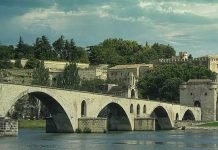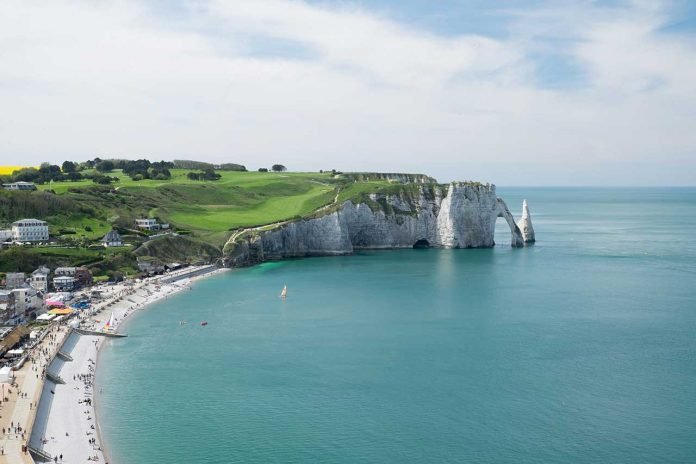Situated in the Normandy region of Northern France, the enchanting village of Étretat garners universal adulation for its breathtaking coastal scenery. The crème de la crème of this natural wonder is undeniably the dramatic white cliffs, arches, and needle-like formations that skirt the town, sculpted meticulously by the tempestuous Channel tides.
Bordered by the bustling port city of Le Havre to the south and the historic town of Fécamp to the north, Étretat is a painterly spectacle, etching its indelible mark on the Côte d’Albâtre, or Alabaster Coast, as it’s affectionately known. As an observer, you are invited into an awe-inspiring dance between land and sea, where chalky cliffs, draped in emerald-green vegetation, cascade into the turbulent cerulean sea below. The three natural arches – Porte d’Aval, Porte d’Amont, and Manneporte – along with the pointed ‘Aiguille’ or ‘Needle’, are nothing short of geological poetry, shaping an unforgettable shoreline tableau.
An Artist’s Paradise
Étretat has been the muse of many eminent figures in art and literature throughout the centuries, its unique landscape serving as a canvas for their creativity. The Impressionist painter Claude Monet is perhaps the most renowned of these, with multiple canvases dedicated to the ethereal beauty of the Étretat cliffs. Their luminescent quality, particularly during sunrise and sunset, rendered the cliffs an irresistible subject for Monet, shaping a series of paintings that continue to captivate audiences worldwide.
Literary Resonance
The cliffs’ enigmatic charm has also resonated deeply within the realm of literature. Celebrated French author Guy de Maupassant, a native of Normandy, featured Étretat in his narratives, with the famous ‘Aiguille’ serving as a secret hiding place for a treasure in ‘The Englishwoman of Étretat’. The town’s dramatic scenery even seized the imagination of the master of suspense, Sir Arthur Conan Doyle, inspiring him to set his Sherlock Holmes adventure ‘The Adventure of the Devil’s Foot’ in this evocative landscape.
Nature’s Art Gallery
Étretat’s remarkable geography lends itself to leisurely exploration. A walk along the pebbled beach provides a ground-level view of the cliffs, while hiking trails along the clifftops grant panoramic vistas that are worth the uphill climb. The most adventurous visitors might also opt for a boat tour to appreciate the cliffs from a different perspective.
Gastronomical Delights
After soaking in the splendor of Étretat’s natural grandeur, it’s time to embark on a culinary journey. Being in Normandy, you are in the epicenter of some of France’s most lauded culinary traditions. Sample the freshest seafood, indulge in local cheeses like Camembert and Neufchâtel, or treat yourself to the region’s famous apple-based drinks, Calvados and Cider.
The Allure of Nearby Towns
Extend your stay by exploring the surrounding areas, each rich in history and charm. Visit the port city of Le Havre, a UNESCO World Heritage Site renowned for its post-war architecture. Discover Fécamp with its impressive Gothic cathedral and the famous Palais Bénédictine, a liqueur distillery doubling as an art gallery and museum.
The cliffs of Étretat and the Normandy coast are undoubtedly a masterpiece etched by nature’s hand, a testament to the transient yet eternal beauty that surrounds us. Whether you’re an art enthusiast, a history buff, a foodie, or simply someone who appreciates nature’s splendor, Étretat promises an encounter that will linger in your memory, long after the chalky dust from the cliffs has been brushed off your shoes.



















